Related Research Articles
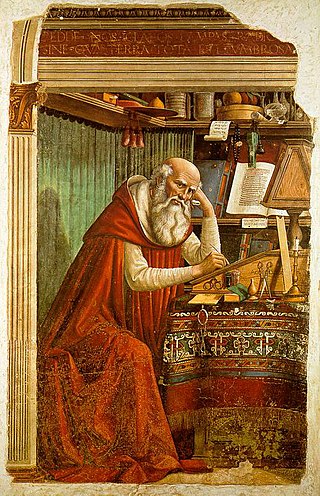
The Liber Pontificalis is a book of biographies of popes from Saint Peter until the 15th century. The original publication of the Liber Pontificalis stopped with Pope Adrian II (867–872) or Pope Stephen V (885–891), but it was later supplemented in a different style until Pope Eugene IV (1431–1447) and then Pope Pius II (1458–1464). Although quoted virtually uncritically from the 8th to 18th centuries, the Liber Pontificalis has undergone intense modern scholarly scrutiny. The work of the French priest Louis Duchesne, and of others has highlighted some of the underlying redactional motivations of different sections, though such interests are so disparate and varied as to render improbable one popularizer's claim that it is an "unofficial instrument of pontifical propaganda."
Pope Adrian II was the bishop of Rome and ruler of the Papal States from 867 to his death. He continued the policy of his predecessor, Nicholas I. Despite seeking good relations with Louis II of Italy, he was placed under surveillance, and his wife and daughters were killed by Louis' supporters.

Pope Anastasius IV, born Corrado Demetri della Suburra, was head of the Catholic Church and ruler of the Papal States from 8 July 1153 to his death in 1154. He is the most recent pope to take the name "Anastasius" upon his election.
Pope Benedict III was the bishop of Rome and ruler of the Papal States from 29 September 855 to his death.

Pope Sergius I was the bishop of Rome from 15 December 687 to his death, and is revered as a saint by the Roman Catholic Church. He was elected at a time when two rivals, Paschal and Theodore, were locked in a dispute about which of them should become pope. His papacy was dominated by his response to the Quinisext Council, the canons of which he steadfastly refused to accept. Thereupon Emperor Justinian II ordered Sergius' arrest, but the Roman people and the Italian militia of the exarch of Ravenna refused to allow the exarch to bring Sergius to Constantinople.
Pope Nicholas I, called Nicholas the Great, was the bishop of Rome and ruler of the Papal States from 24 April 858 until his death. He is remembered as a consolidator of papal authority, exerting decisive influence on the historical development of the papacy and its position among the Christian nations of Western Europe. Nicholas I asserted that the pope should have suzerainty over all Christians, even royalty, in matters of faith and morals.
The Gregorian Reforms were a series of reforms initiated by Pope Gregory VII and the circle he formed in the papal curia, c. 1050–80, which dealt with the moral integrity and independence of the clergy. The reforms are considered to be named after Pope Gregory VII (1073–85), though he personally denied it and claimed his reforms, like his regnal name, honoured Pope Gregory I.

Saeculum obscurum, also known as the Pornocracy or the Rule of the Harlots, was a period in the history of the papacy during the first two thirds of the 10th century, following the chaos after the death of Pope Formosus in 896 which saw seven or eight papal elections in as many years. It began with the installation of Pope Sergius III in 904 and lasted for 60 years until the death of Pope John XII in 964. During this period, the popes were influenced strongly by a powerful and allegedly corrupt aristocratic family, the Theophylacti, and their relatives and allies. The era is seen as one of the lowest points of the history of the papal office.
Anastasius Bibliothecarius was the librarian (bibliothecarius) and chief archivist of the Church of Rome and also briefly a claimant to the Papacy.
Ermengard of Italy was Queen of Provence as the spouse of King Boso. She was the second and only surviving child of Emperor Louis II. In her early life, she was betrothed to Constantine, the junior Byzantine emperor, but whether the marriage actually occurred or not is still debated among historians. In 871, Ermengard and her family were taken hostage by Adelchis of Benevento but were later freed. In 876, Ermengard married Boso, a nobleman with connections to the Carolingian dynasty, and became queen upon his accession to the throne of Provence in 879. After her husband's death in 887, she served as regent of the kingdom during the minority of her son Louis the Blind.
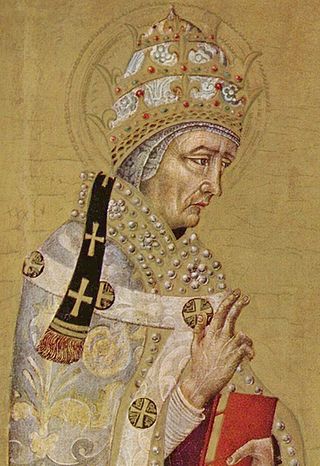
The selection of the Pope, the Bishop of Rome and Supreme Pontiff of the Catholic Church, prior to the promulgation of In Nomine Domini in AD 1059 varied throughout history. Popes were often putatively appointed by their predecessors or by political rulers. While some kind of election often characterized the procedure, an election that included meaningful participation of the laity was rare, especially as the Popes' claims to temporal power solidified into the Papal States. The practice of papal appointment during this period would later result in the putative jus exclusivae, i.e., the claimed but invalid right to veto the selection that Catholic monarchs exercised into the twentieth century.
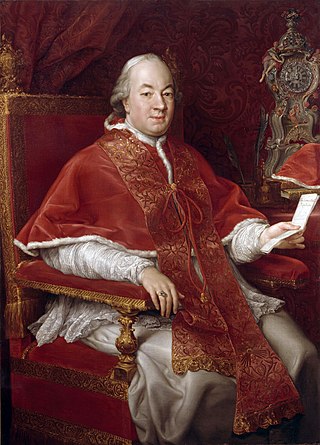
The 1774–75 papal conclave, was convoked after the death of Pope Clement XIV and ended with the election of Cardinal Giovanni Angelo Braschi, who took the name of Pius VI.
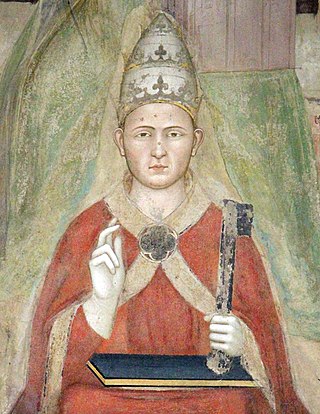
The 1304–1305 papal conclave was initiated after the death of Pope Benedict XI in July 1304. The conclave took place in Perugia, the city in which Benedict had died, and proved to be a protracted affair. It ran from 10 or 17 July 1304 to 5 June 1305, and ultimately elected the non-cardinal Raymond Bertrand de Got as Pope Clement V. At the time of his election de Got was Archbishop of Bordeaux, and thus a subject of Edward I, King of England, although he was a childhood friend of Philip IV of France. Clement V's decision to relocate the papacy to France was one of the most contested issues in the papal conclave following his 1314 death, during which the minority of Italian cardinals were unable to engineer the return of the papacy to Rome. This immediately preceded the beginning of the Avignon Papacy.

The 1769 papal conclave, was convoked after the death of Pope Clement XIII. It elected as his successor Cardinal Lorenzo Ganganelli, who took the name Clement XIV.

The Ostrogothic Papacy was a period from 493 to 537 where the papacy was strongly influenced by the Ostrogothic Kingdom, if the pope was not outright appointed by the Ostrogothic King. The selection and administration of popes during this period was strongly influenced by Theodoric the Great and his successors Athalaric and Theodahad. This period terminated with Justinian I's (re)conquest of Rome during the Gothic War (535–554), inaugurating the Byzantine Papacy (537–752).
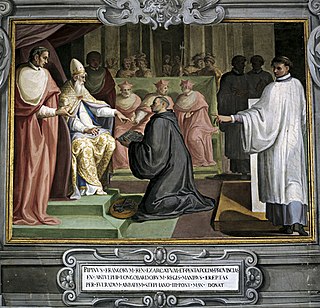
From 756 to 857, the papacy shifted from the influence of the Byzantine Empire to that of the kings of the Franks. Pepin the Short, Charlemagne, and Louis the Pious had considerable influence in the selection and administration of popes. The "Donation of Pepin" (756) ratified a new period of papal rule in central Italy, which became known as the Papal States.
Peter was a Bulgarian noble and relative of knyaz (khan) Boris I who was in charge of diplomatic missions during the Christianization of Bulgaria. His position in the Bulgarian administrative hierarchy is unknown but it has been suggested that he had the title kavhan, i. e. the second person in the state after the monarch.

The 1099 papal election following the death of Pope Urban II took place on 13 August 1099. Before his death, Urban had designated Cardinal Rainerius da Bieda as his successor. The cardinal-electors, with the consent of the lower Roman clergy, chose Rainerius, who, after a flight and over his considerable objections, accepted and took the name Paschal II. He was consecrated a bishop and crowned pope on the next day.

Mark Sittich von Hohenems Altemps (1533–1595) was a German Roman Catholic bishop and cardinal. The addition of Altemps to the family name reflects Alt-Ems itself deriving from "Alta Embs", like the modern name Hohenems.
References
- ↑ Loughlin, James Francis (1907). "Pope Adrian II" . In Herbermann, Charles (ed.). Catholic Encyclopedia. Vol. 1. New York: Robert Appleton Company.
- ↑ Riche, Pierre (1993), The Carolingians, University of Pennsylvania Press, ISBN 9780812213423
- ↑ The Religion of Rome described by a Roman: Authorised translation by William p. 293
- ↑ Fernand Mourret: A History of the Catholic Church, Volym 3. B. Herder Book Company, 1946
- ↑ Loughlin, James Francis (1907). "Pope Adrian II" . In Herbermann, Charles (ed.). Catholic Encyclopedia. Vol. 1. New York: Robert Appleton Company.
- ↑ Helen Parish (2016). Clerical Celibacy in the West: C.1100-1700. Taylor and Francis. pp. 49–51. ISBN 9781317165163.
- ↑ Dopierała, K. (1996). Księga Papieży. Poznań: Pallotinum. p. 106.
- ↑ Riche, Pierre, The Carolingians
- ↑ Alexander Penrose Forbes Articles XXII to end 637
- ↑ Dopierała, K. (1996). Księga Papieży. Poznań: Pallotinum. p. 106.
- ↑ William Cornwallis Cartwright On Papal Conclaves 123